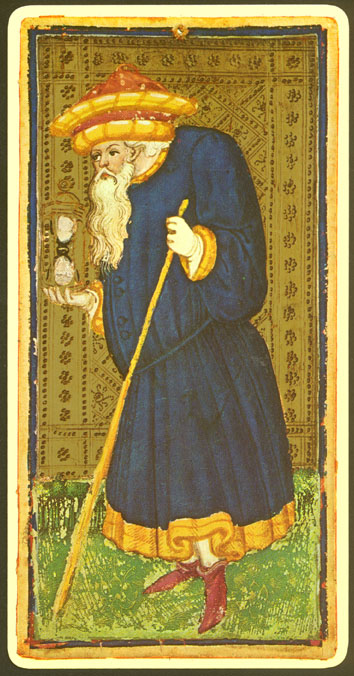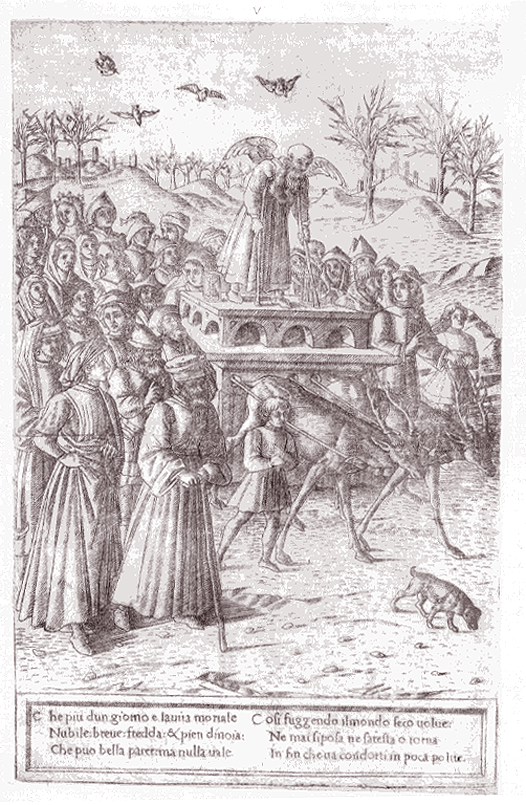Huck
The crowned one said:Thanks for the general directed kind words Huck, I am comfortable, just have nothing to add.
That's good, that you feel comfortable ... me actually would have found maybe 20 questions in my own written short post above perhaps only some years ago ...
************
"Michelino deck" [What's this?], Boiardo Tarocchi poem [What's this?] and Sola Busca Tarocchi [What's this?] are facts of Tarot history in 15th century, one can't discuss them away.
Christian figures appear in the so-called standard Tarot, they are also present. Naturally all decks somehow mirror their "own specific time", and with that I mean not "15th century" generally, but more precise dates.
Sola Busca would have been very unlikely for 1450 (no copperplate engraving [Did you know, that this was copperplate engraving?], very different in sexual behavior [What's the guy is thinking of?]) or for 1497 (time of prohibition in Florence [Was there a prohibition in Florence? Which?]and Ferrara [Was there a prohibition in Florence? Which?]) for instance. Boiardo Tarocchi (likely 1487 [Why 1487?], "women are better than men" [Who said that?]) reflects a position, which became popular in Ferrara ca. 1485 []Why and how?], not before.
Filippo Maria had been "very modern" [Was he?], so it was possible to create the Michelino deck c. 1425[Why this date?], but Filippo Maria was attacked publicly in this time by San Bernardino [Did he? Which context?]. And the Michelino deck meets the relative new enthusiasm about the import of Greek manuscripts [, likely not accidently, but by by causal relation.
We don't know all and everything about playing cards in 15th century. There might have been also games with Saints. In the Rosselli [Who's that?] inventory from 1528 [What happened then?] there was printing material for a game with 12 apostles, as far I remember. Ringmann [Who's that?]used figures on cards to teach Latin grammar 1509. Murner [Who's that?]made cards to teach logic (1507) and cards, which show heraldic (1502)[Did he really make two card games?]. In Strassburg and Mainz printers [Who?] used playing cards for divination (1505) [Oh, really?] in the popular form of lot books.
In the new Italian book "Castello di Tarocchi" Andrea Vitali shows some cards, which were made with woodcuts from the Schedel'sche Weltchronik 1493. [How do they look? Which topics?]
... .-) ... Chess figures (as paintings or engravings) also had a specific iconography [Do you know some?].
**********
Well, if you've an answer to 10-20% of the questions, you're a rather promising beginner
If you've an answer to about 40% you're really good
If you can answer about 70% you're fantastic
If you has some opinion about 80-90% ... you belong to very few persons that do so ..
If you say, that you know 100 % ... that looks rather impossible, it seems, you're a liar ... .-)

from "Il Castello dei Tarocchi", Andrea Vitali etc.., 2010
... I guess, you don't know that
***********
A Forum is a process, which consists of dialogs. If we wish to publish in single authorship, we can publish on websites or books.
And for dialogs there is the rule, that, where there are no questions, there are no answers ... although naturally the questions exist and the answers possibly also, but just momentary not in this dialog.
No dialogs make an empty lifeless forum.
*************
That mirrors luckily and actually not the state of Tarot History research ... there were considerable advances in the past 10 years ...





